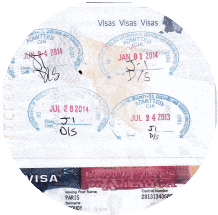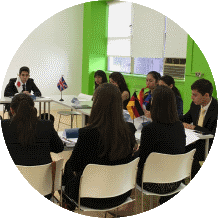 Inviting an international teacher to work in a US school involves more than the financial commitment to pay the teacher sponsorship fee for a J-1 exchange visa. There are responsibilities involving a deeper commitment.
Inviting an international teacher to work in a US school involves more than the financial commitment to pay the teacher sponsorship fee for a J-1 exchange visa. There are responsibilities involving a deeper commitment.
A specific staff person needs to be assigned to personally assist every international teacher. Accompany them to the Driver License and Social Security offices, as well as to the local bank, to assist them in opening a checking accounts. Of course, you need to help them find a place to live and buy a car. It is part of your responsibility.
It is the public school district’s duty to get information about the requirements for foreign teacher licensure in the state and assist the teachers through the process. Urge international teachers to travel to the US early enough to process their Social Security numbers. In Oregon, the teaching license is issued after the social security number is on file.
Most established international, immersion, and public schools with foreign language /immersion programs offer some or all of the services described here. This article is geared toward steps to take for schools accepting their first foreign teacher into the fold, or review if you already sponsor foreign teachers.
Providing relocation orientation and direct support to new foreign hires is essential to help quickly familiarize themselves with the new community, school, and feel welcome, softening the severity of Culture Shock. The importance of creating an atmosphere of good will and support for a smooth and successful exchange experience cannot be underestimated. School staff may not realize that the challenges ahead for the teacher may be overwhelming. A few simple steps can help avoid bewilderment and do much to help orient a new hire not familiar with the area to life in the United States in general.
Successful employers usually appoint 1-2 buddy or mentor teachers for each new foreign exchange teacher before and immediately after the foreign exchange teacher’s arrival. Much of the following information is covered in the Cordell Hull Foundation Pre-Arrival and Orientation Manual. A few important points are summarized briefly in this checklist.
- Social Security Card
Provide practical assistance and transportation. Applying for a SSN should be one of the first tasks for the foreign teacher. The nearest Social Security office is easily identified via Internet by navigating to http://www.socialsecurity.gov and inputting the school zip code. Immediately after the teacher arrives, s/he must inform the Cordell Hull Foundation first to “validate” the arrival in the SEVIS database.
- State Driver’s License
Ensure the foreign national is familiar with your state’s driver’s license rules and laws which may be accessed on DMV (Department of Motor Vehicle) websites. The template is “www.dmv.__.gov” Insert the two-letter abbreviation for the state to find the driving laws that pertain to your state, i.e. California: www.dmv.ca.gov. Explain that a driver’s license serves as the main ID in the US for opening bank accounts, renting housing, and other tasks that are difficult or impossible without it. If a teacher does not plan to drive, s/he can also apply for a US ID card at the same DMV location.
- Accommodations
Think about options to house the exchange visitor for the first few days after arrival. Of course, a host family is an ideal temporary solution so that foreign nationals have someone familiar with the area to ask for advice. Simple, inexpensive motels are one option. Extended stay hotel/apartments may be worth considering if finding a suitable apartment is expected to take some time. Some former exchange teachers receive excellent help from their schools or hiring districts such as a current list of nearby apartment offices (with respective business hours), lease range and deposit amount or real estate offices. It is helpful to point out and write down convenient neighborhoods as far as prices, distance to your institution, transportation routes, plus also possible areas to avoid.
It is crucial to help the foreign teacher in locating decent living space. Schools and districts must understand that, while finding a place to live seems like the teacher’s sole personal business, it will backfire on the school’s work and success if it remains unsolved for too long. Inform the new hire about possible furniture leasing businesses, inexpensive furniture stores (i.e. IKEA), and explain garage sales as one alternative.
- Phone, Cable, Internet options as well as other utilities
Provide the address and business hours of Public Utilities Boards where the new teacher can apply for gas, water, and electricity hookup. It is extremely helpful to give your new colleague an overview of existing carriers in your area, price plans, and inexpensive alternatives. While most exchange teachers are familiar with Skype for long-distance calling, you may have to point out the benefits (and possible implications) of cell-phone contracts and pay-as-you-go options (Net10 offering international calling).
- Car and transportation alternatives
A list of trustworthy second-hand dealers is incredibly valuable. Some school districts work with their local teachers’ credit unions to help foreign exchange teachers finance cars. Explain all transportation alternatives, especially during the first few days and weeks.
- Bank account
Inform foreign exchange visitors about options, and ideally assign a staff member to accompany them to a bank to fill out the application. Some banks have special offers and packages and may even reward you for bringing in new customers. Not all foreign teachers are fully familiar with the U.S. system of debit vs. credit cards, personal checks, and online banking. Let teachers know that establishing credit in the US can take up to six months, and advise them of local department stores or businesses that may give them credit to start the ball rolling. Ensure that direct deposit is an option for bank accounts.
- Tax exemption
Exchange teachers should know whether or not they are tax exempt. Make sure they complete Form 8233 and give it to the school when they first arrive, then in January of each subsequent year, in order to qualify for a J-1 visa tax exemption. All new J-1 teachers are eligible for exemption from Social Security and Medicare taxes for the first two years in the US. Some countries have tax treaties with the US exempting J-1 visaholders for 2-3 years from federal (not state) income tax. Detailed charts are provided in the Cordell Hull Foundation Orientation and Pre-Arrival Manual link provided in your initial J-1 visa instruction letter: cordellhull.net/PW10
Also see CHF’s FAQs page on tax exemption:
https://cordell-hull.org//are-teachers-sponsored-on-a-j-1-exchange-visitor-visa-tax-exempt/
- Health Insurance
J-1 visa Federal regulations require all exchange teachers to be insured. See the first article in this blog on how to obtain this insurance and the specific requirements. http://j1visateachexc.blogspot.com Some teachers are from countries that offer free medical coverage to all citizens but teachers must buy an international rider for this insurance to be valid in the U.S.
- Social Security, Teacher Retirement System, other deductions
Please make sure that the foreign teacher understands all of these. In many cases, contributions to state teacher systems can be refunded at the end of the exchange (after the three-year J-1 visa tenure). Try to send a staff member who is a native speaker of English to accompany the teacher to apply for their social security card, as they sometimes get impatient with people who speak slowly or with an accent (!) which is not welcoming.
- Paychecks
Provide information on cut-off days, and, most importantly, the new employee’s first pay day. Be prepared to answer questions regarding your school’s relocation assistance if a stipend is offered as part of the contract.
- Sick Days / Personal Business Days
Ensure that your new colleague understands your school and/or district policies on absences and tardiness. Be sure to give the employee handbook to the foreign teachers when they first arrive or during orientation.
- Clubs, Pastime options, Ways to get involved in the community
CHF asks foreign exchange teachers to participate actively, get to know the U.S., its way of life, and people. Try to put yourself in the foreign visitor’s place and come up with some interesting offers of “meet-up” clubs, inside and outside the school community, and invite them to activities giving them a chance to mingle with American people. Most foreign exchange visitors are eager to share with others information on their home countries and schools, beyond the scope of your school. They realize it is one of the purposes of the teacher exchange program but need your support and guidance on venues to share this valuable and enriching information.
- Setup of school work
Buddy teachers should also introduce the foreign national to important aspects of school life: School administration hierarchy, school districts, unions, role of the principal, daily routines, paperwork, professional development, classroom management rules, and grading system. While this info is usually provided in an official manner by the institution’s administrators, it is not necessarily easy to follow and understand for speakers of other languages. When the appointed buddy teacher revisits these facts and regulations on a more casual, informal level through personal stories, explanations, and examples, it proves extremely helpful.
- Contact with the Cordell Hull Foundation
The new exchange teacher must know how to contact the J-1 visa sponsor, the Cordell Hull Foundation, and requirements for keeping J-1 visa status in good standing. The email address is: pro@cordellhull.org After they participate in the required CHF orientation seminar for new teachers, encourage teachers to talk about their adjustment to life in the U.S., and to ask for help with culture shock.
Taking some of these steps involves additional work but will pay off. New teachers can almost immediately focus attention on their work for the school rather than feel overwhelmed by filling out forms and other tasks connected to relocating and not understanding how to take the necessary next steps.
15. Work Permit for J-2 Spouse
The Form I-e765 can be quite complicated for a non-native speaker of English. Refer teachers to the Cordell Hull Foundation list of Instruction Videos, www.cordellhull.com/instruction-videos and encourage the spouse to watch the Work Permit video to explain the process in any of four languages. Then assign a school staff person to help the spouse fill out the form online. Having this permit delayed is one of the biggest sources of distress for foreign teacher couples. If they do not include every single document and fill in every blank correctly, Homeland Security will return the application and they will have to correct the errors or omissions, send them in again, and wait longer to receive approval. In some states it can now take four months to obtain an EAD (Employment Authorization Document) card. J-2 spouses also need this card in order to apply for a Social Security number.
You can imagine that it is advisable for a spouse to obtain a job as soon as possible so that they feel their own personal connection to the American way of life. It helps open outlets for them to form their own friendships and to expand objectivity for the couple beyond the school.






